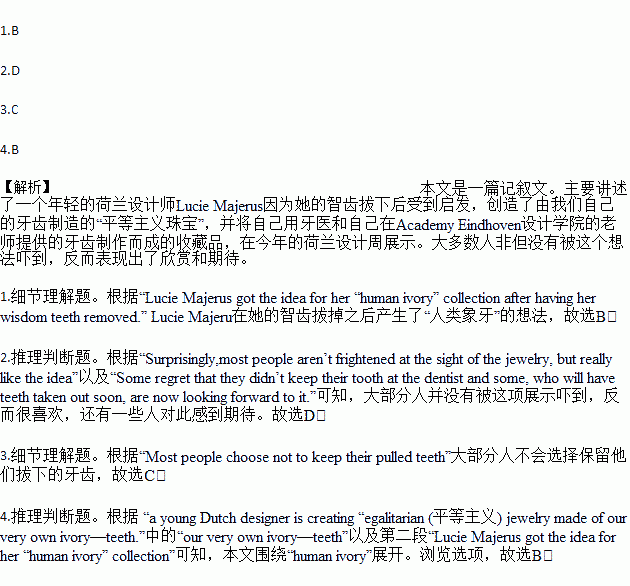题目内容
In a time when ivory poaching (偷猎) has gotten so bad that it threatens to wipe out several animal species, a young Dutch designer is creating “egalitarian (平等主义) jewelry^ made of our very own ivory—teeth.
Lucie Majerus got the idea for her “human ivory” collection after having her wisdom teeth removed. She kept them and soon realized they would make great material for a jewelry collection. “Why wouldn’t we value our own material instead of the precious material from other species? And what if we mine our own ivory and turn it into pearls?” she asks.
Her own teeth became a ring,but in order to create a whole collection, she needed more material, and since having more of her teeth removed wasn’t a very pleasant choice, she asked her dentist to save his patient’s unwanted teeth. Most people choose not to keep their pulled teeth, so they are usually donated to dentistry schools. Majerus also received the lost teeth of two of her teachers at Design Academy Eindhoven, so she had a nice supply of human ivory to experiment with.
To turn human teeth into attractive pieces of jewelry, Lucie Majerus first bleaches (漂白) them, and then uses a stone polishing machine to shape the teeth into various shapes.
Majerus displayed her human ivory jewelry collection at this year’s Dutch Design Week, and claims that people’s reaction was mostly positive. “Surprisingly, most people aren’t frightened at the sight of the jewelry, but really like the idea,” Majerus told Fast Co Design. “Some regret that they didn’t keep their tooth at the dentist and some, who will have teeth taken out soon, are now looking forward to it.”
1.When did Majerus get the idea of collecting human ivory?
A. After she bought a ring.
B. After her wisdom teeth were pulled out.
C. Before she was lacking in pearls.
D. Before her wisdom teeth appeared.
2.Seeing Majerus’s human ivory jewelry collection, most people felt .
A. frightened. B. curious
C. sad D. interested
3.It can be inferred form the next that .
A. Majerus is the first woman to create jewelry using human teeth
B. other species teeth are more precious than human teeth
C. most people don’t like keeping their pulled teeth at home
D. Majerus’s teachers objected to her experiments with teeth
4.What may be the best title for the text?
A. Elephants and Ivory
B. Human Ivory Jewelry
C. A Designer Removed Her Teeth
D. The Drawbacks of Human Teeth
 金牌教辅培优优选卷期末冲刺100分系列答案
金牌教辅培优优选卷期末冲刺100分系列答案生活中冲突时有发生。假设你班同学苏华和李江打篮球时发生争执,导致关系紧张。请你结合此事,并根据以下提示,用英语写一篇短文,向学校英文报“Happy Teens”专栏投稿。
简要描述事情的经过 | 打篮球、碰撞、争执,等等 |
分析发生冲突的原因 | 1.遇事不够冷静 |
2. …… | |
谈谈避免冲突的做法 | 1. …… |
2. …… |
注意: 1. 对所有要点逐一陈述,按要求适当发挥,不要简单翻译。
2. 词数120 左右。开头已经写好,不计入总词数。
3. 作文中不得提及有关考生个人身份的任何信息,如校名、人名等。
参考词汇:碰撞bump into;争执;争吵quarrel;以自我为中心的self-centered;体贴的considerate;冷静的calm;彼此责怪blame each other;谅解forgive;处理冲突handle conflicts;明智地wisely
Conflicts with others are common in everyday life._____________________________________________
___________________________________________________________________________________________________________________________________________________________________________________________________________________________________________________________________________________________________________________________________________________________________________________________________________

